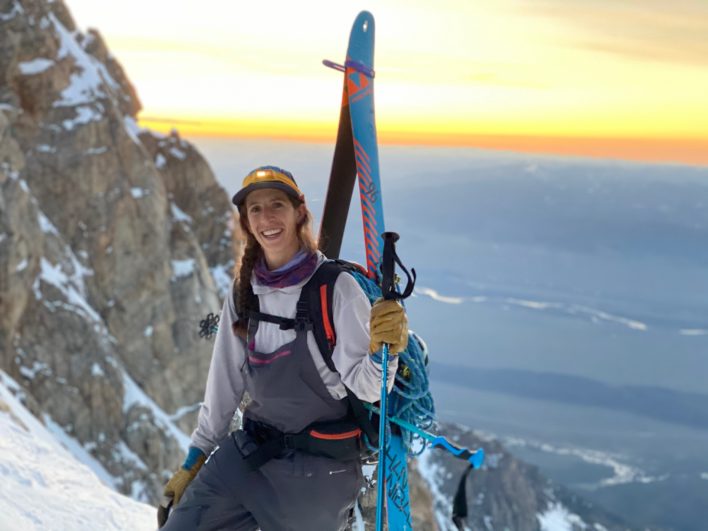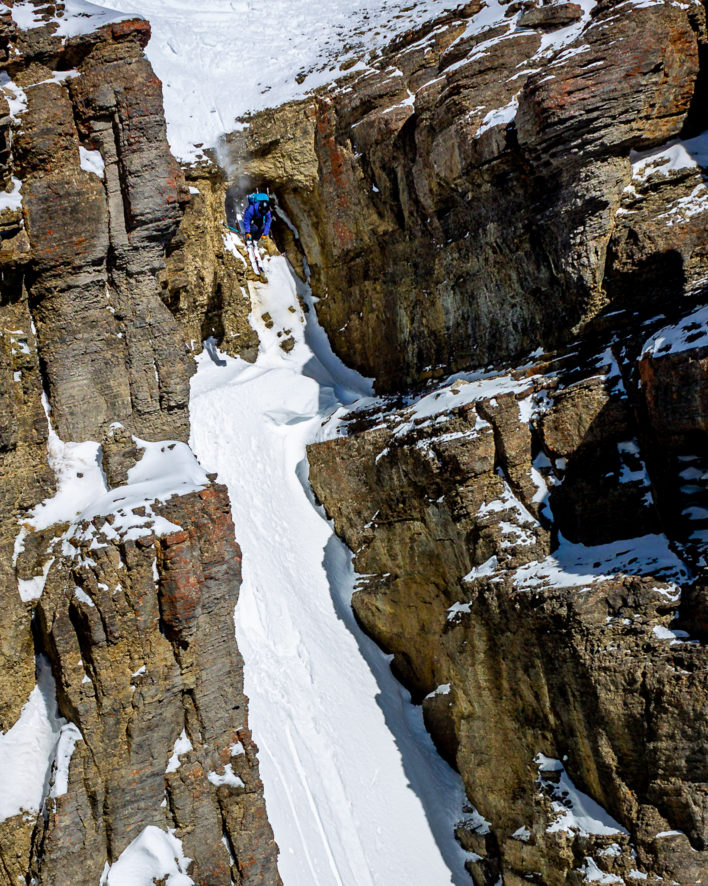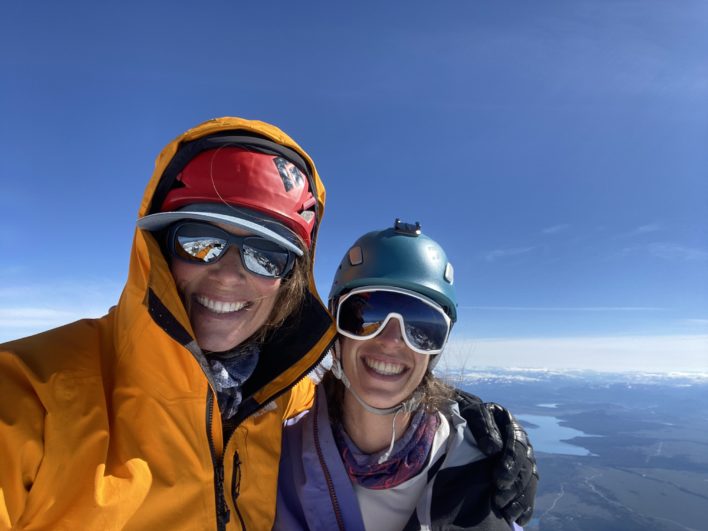Former U.S. Ski Team member Sophia Schwartz is all about setting goals. It used to be going to the Olympics for moguls, but after narrowly missing out on making the Olympic team in 2014, she’s pivoted and sought out new, diverse goals. This past season, that included landing a double backflip, skiing Wyoming’s Grand Teton (13,775 ft.) and linking up the “Jackson Hole Trifecta” in the Jackson Hole Mountain Resort sidecountry. This developed into the premise for a ski movie, Jack of All Trades, that premiered on November 10. When I caught up with Schwartz, she shared her thoughts trip planning, privilege and the importance of backcountry mentorship. —Annie Frodeman

Backcountry Magazine: When did you begin backcountry skiing? What was your first backcountry experience like?
Sophia Schwartz: I started backcountry skiing three years ago. I was a competitive mogul skier for a long time and always knew I wanted to get into more big mountain stuff. I suffered a back injury which was kind of the end of my mogul skiing career and spurred my transition. But my first-ever, real backcountry experience was a three-day hut trip with a bunch of friends in Colorado. I went to the store and had to rent boots and gear, because I didn’t own any of it and ended up having nasty foot cramps and all sorts of struggles, but it was so fun. It was really cool to get out with my friends and stay in a hut and to see a different side of skiing.
BCM: Can you talk a little bit about some of your longer backcountry adventures, like your Wind River Range traverse?
SS: The Wind River trip came out of our trip to Denali getting canceled. We had spent the whole winter preparing for that mission and then Covid-19 hit in March. Our planning for the Winds was pretty short compared to the amount of information we had around Denali. The Wind River Range is just a really remote area without a lot of information. I went with two people, Iain Kuo and Ian Johnston. Kuo did a lot of the route finding. We sat down together and went on to Google Earth and kind of mapped out this adventure based on some of the hiking trails and then exported it to Gaia GPS. I did a lot of the meal prep which was fun. I looked at what was the most calorie-dense food per weight and tried to think about what we would want a balance of.
The Winds are cool because you go up and over all these mountain passes. When we got to the top of a mountain pass we would rip skins, transition and ski down. But when we skied down we had to deal with our sleds that we used to help carry a lot of our gear so that our packs weren’t overwhelmingly heavy. There were three of us and we had two sleds. So every once in a while I pulled the lucky straw and got to ski down the pass without having to manage a sled.
In terms of how to deal with weather and snow conditions, you really have to buffer in weather days and just assume that there will be days where it might not be safe at all. You need make sure you have enough supplies, giving yourself a buffer because you don’t really have the luxury of choosing different terrain. It is helpful to create a route that has a bit more margin for error. For example, when we climbed up the pass that took us into the Cirque of the Towers, we found a massive cornice. We were stumped; it was too windy, too nasty outside, so we ended up having to come back down and actually go all the way around to this other pass. We also used the Garmin inReach so we could get some weather updates while in the field. Trusting their weather reports was huge.
BCM: What do you do to make sure that the conditions are safe for backcountry skiing?
SS: I read the avalanche report every morning, regardless of whether I am sitting at work or actually about to go skiing. I also invest in my education. I think it is really hard to swallow spending like $500 on an avalanche course, but I have taken both my Level 1 and Level 2 avalanche course and plan to invest in taking an avalanche education course every year. It is just in my ski budget. If I am going to invest in boots or other equipment, then I am going to invest in education as well. I also try to learn from as many people as possible. I think that finding partners you can learn from can be the hardest part.
Another thing is that I have this funny rule I call the Rule of Three Whys. Whenever we are headed out to the backcountry, I try to ask “why” at least three times. To start I will ask, “Why is this run safe?” The answer might be, “It’s safe because the avalanche danger today is moderate.” Then I will ask another two “whys.” I think it’s important to always go a level deeper and to not settle for just the generic “It’s safe because it is.” This has really accelerated my own learning. It is really fun to take people out and see how much I have learned when they ask me why, and it feels good to have a real answer, not just, “I know because I skied this yesterday or it is because this website said it is.”

BCM: You mention mentorship and privilege in the ski industry in Jack of All Trades. What do you mean by this and what are some ways that we can combat the exclusiveness of skiing?
SS: The conversations around privilege are prominent right now and the ski community is not immune. Skiing is just a microcosm of the bigger issues in the United States around race, sex and socioeconomic status. Skiing has been an inherently white sport. It came to the U.S. as this elite hobby from Europe and was developed out west, which has a history of white people having access to the land. This history really shapes where we are now with skiing. Being able to combat it takes purposeful effort.
In backcountry there isn’t the same support network that you have in other parts of the ski industry. If you are a beginner and want to learn how to ski, you can sign up for lessons at the resort. But in backcountry there is a big gap between taking your avalanche courses and getting out there. You basically have to hire a guide, which is expensive, and most people don’t even know that you can go to these guiding companies to get taken out. So you end up being really reliant on mentorship. I think mentorship can be troublesome because of the history of who has had access to this information—white men—means that white men tend to pass down their knowledge to other white men. It has been cool to see women more and more in these spaces, but, again, white women tend to pass down their skills to other white women.
There is also this idea about who is safe to bring into the backcountry and implicit biases around this happen really quickly. Are they wearing the right clothes? Do they look a certain way? I have found that privilege has really accelerated my learning in the backcountry. I am able to say, “I was on the U.S. Ski Team,” and this means people know that I can ski a certain way, but they also give me more credit than I deserve in my knowledge of the mountains. Three years ago, I had only ever backcountry skied once. Yet they were willing to take me out because I have this previous history that instilled in them a trust that I didn’t necessarily deserve.
BCM: Do you have any thoughts on how to make skiing more available to people outside the traditional white, male, and now increasingly female, ski mold?
SS: Definitely. I think that most ski communities tend to have some connection to the nonprofit world and to these populations who have been marginalized in the ski community. Here in Jackson we have a huge Latinx population. Twenty-five to 30 percent of our community is Latinx, yet you don’t see that same representation on our ski slopes. I volunteer for Coombs Outdoors which helps integrate our community through outdoor mentorship. Every Sunday in the winter I ski with a group of high school girls. It is an opportunity for me to give them not only ski lessons, but life lessons. Secondly, I think social media plays a big role. There are pages like Melanin Base Camp that show athletes from diverse backgrounds. A third way is being brave and having it be one of your goals. When you make your season goals, include something like, “I want to take someone out who hasn’t skied that much backcountry and I teach them what I know.” The next time you are sitting next to someone at a restaurant or on a chairlift and they mention they want to learn, be brave and say, “Hey, here is my number we can go skiing.” This doesn’t mean you have to do this every day, but maybe just five days out of the whole year. This would make an incredible difference in getting people out and keeping people safe. People often have to take risks and go by themselves which just puts everyone in danger in the mountains. Instead of blaming people for not knowing, contribute positively to the issue of safety.

BCM: Have you skied with your role models? You mentioned Lindsey Dyer, Hannah Carney, Kit DesLauriers in the YouTube broadcast of Jack of All Trades.
SS: Those three are definitely huge role models for me. One of the coolest parts of skiing is the close proximity to some of your idols. It was really cool as a little kid to get to go to ski camp and to have U.S. Ski Team members be your coaches and Hannah, Lindsey and Kit have really helped me reach higher levels in skiing whether in mogul competitions, big mountain skiing or in ski mountaineering.
Kit has been a great help in my recent backcountry expeditions. I reached out to her on social media to get some advice on Denali, and we ended up skiing together and became fast friends. She kind of makes me feel normal in a sense. I am a super try-hard and I love training. She just knows so much about the mountains, and it is great to have someone who is down to grind and be a try-hard in the same way that I am. I think a lot of times the ski community likes to make everything look easy, they want it look like they instantly belong and are instantly capable, and that narrative is hard for me because I have had to work really hard to get where I am as a skier. Granted, I have had a lot of privilege to get the opportunity to even have the time and space to put in that work, but a lot of what I have done is simply showing up, putting in the time, asking constantly what I can do better, what am I failing at, and discovering what will I fail at in the future. Kit really represents that style of work ethic and is a model for me.
BCM: You had three goals as the premise for Jack of All Trades. Do you have goals for this upcoming season?
SS: Yes I do. I have lots of goals and I am keeping them secret. Which is not something I have done before, I tend to be very transparent in my goals, but I am feeling a little superstitious so I am keeping them to myself for now. One reason is to take away some of the pressure. I want to get away from having to do it just because I said I would and want to make sure the goals really align for me and are really what I want to do. I want to stay within myself this year.
BCM: Did you have anything else you wanted to add?
SS: The Jack of All Trades project was really fun. Skiing has so many niches: You can be a cross country skier, you can be an alpine racer, you can be a jumper, you can be a backcountry skier. What I like about skiing is that it is a lifelong sport in which lots of different people can find their niche and their love. Whether you are 78 years old and just getting up every morning to ski groomers, or if you are a young kid that wants to huck themselves off things and ski to their greatest capability, skiing has so much room to find what you want. For me that variety really keeps me excited. I want to grow and excel in these different ranges and not get trapped in any one box.
Read more about Sophia Schwartz’s adventures in the Wind River Range in Issue #136, coming to newsstands and mailboxes soon.










Related posts: